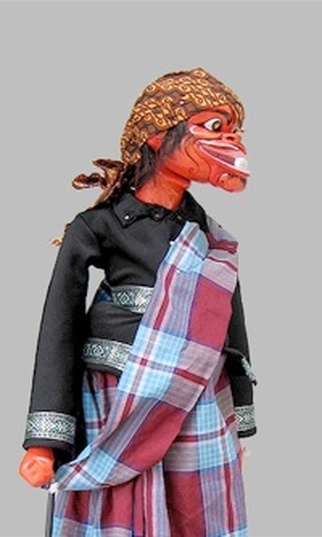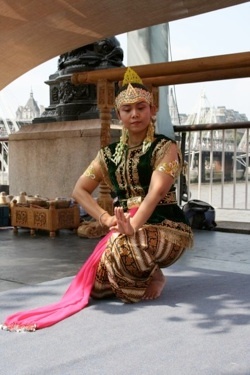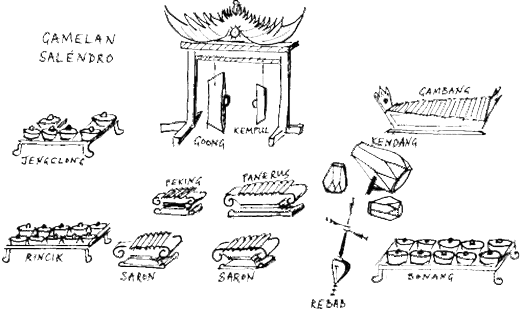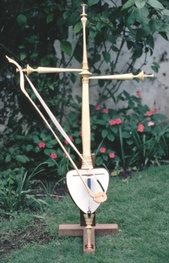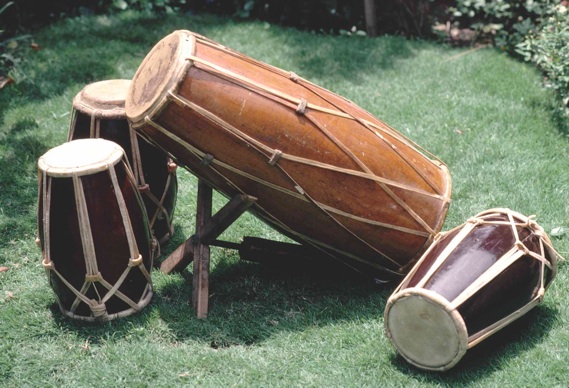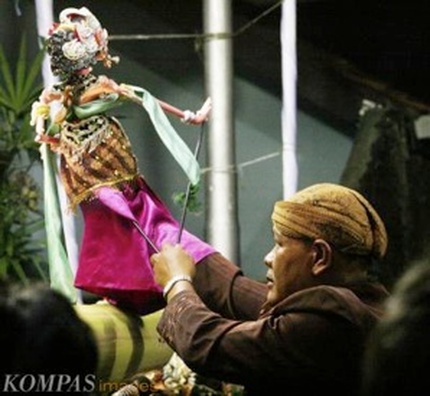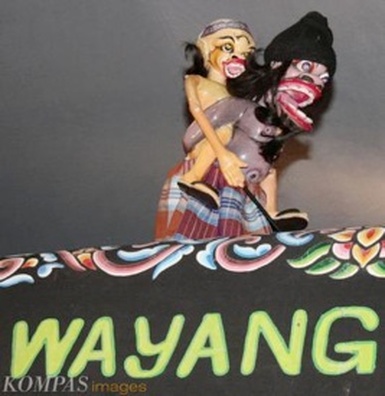|
A set of gamelan salendro resembles a small Javanese gamelan. Sundanese gamelan tend to have a clunkier, less sustained sound, more in keeping with the faster style of playing. Unfortunately in West Java gong-making is in decline, and these days many new Sundanese gamelan are made with the bronze parts imported from Central Java, and tuned locally. Many government institutions in West Java (including SMKI and ASTI: the high school and academy for traditional performing arts) have complete Central Javanese gamelan. These can however be used for playing Sundanese music without too many problems - as indeed can the Javanese gamelan commonly found in the UK.
|
GAMELAN SALENDRO Gamelan salendro is primarily used for accompanying wayang golek (rod puppet theatre) and dance (both classical dance and the more recent social dance jaipongan). It can also be played on its own, although this is now less common, except on the radio. Such concert music (sometimes called kliningan) used to be popular at wedding receptions. Nowadays one usually finds gamelan degung or jaipongan (a social dance with very dynamic drumming) instead.
In broad terms, gamelan salendro, and music in the salendro tuning played on other instruments, are more popular with the common people. The Sundanese elite prefer gamelan degung or tembang Sunda, which were both formerly associated with the courts of the Regents in Dutch times. |
The most obvious difference between Sundanese and Javanese gamelan salendro is that in Sunda the soft instruments with tube resonators (slenthem and gender) are not used. Sundanese gamelan uses one large goong. Only one kempul (small hanging gong) is used. Few Sundanese gamelan include the horizontal gong chimes kenong and kethuk. Instead there is an instrument not found in Java, called jengglong. This consists of 6 flat pots (rather like the large Javanese gong-chimes, bonang panembung) on a horizontal frame like that of a kenong. In gamelan salendro, the pitch is generally the same as the lower octave of the bonang.
|
The rebab (fiddle) is slightly larger and more robust in construction in Sunda than in Java. The body cavity is more shallow. The strings are tenser. Below the bridge the strings are pinched together with a flat piece of bone with a slot cut in it, and below that separated by a piece of rubber. The playing technique differs considerably from that of Javanese rebab: the instrument is held on the left side of the player, and the fingers stop the strings from the side, not from the front. Frequent use is made of harmonics, produced by stopping the string lightly at its mid-point, or at two-thirds or three-quarters of its length. Its tone quality and musical function are quite different from those of the Javanese rebab.
|
A standard set of Sundanese kendang consists of one large drum (kendang ageung or kendang indung) and two small ones (kulanter). The kendang ageung looks like a large Javanese kendhang ciblon. They vary in size: smaller shriller instruments are used to accompany the popular dance jaipongan. The large drum is set at an angle of 45 degrees on its stand, with the large head resting on the floor. This enables the player to press the head of the drum with his heel in order to obtain different pitches. Loops of string attached to the kendang and looped round both the drummer's big toes prevent the drum from sliding about. The internal shape of the drum (which is rather different from that of Javanese drums) makes the different pitches easier to produce. Most Sundanese kendang players have the large head of the kendang ageung on their left. However, two of the most famous players, Mang Tosin Muchtar and Mang Bao, played the other way around (ie like Central Javanese kendhang). One kulanter is placed upright so that its small head is next to the small head of the kendang ageung. The other kulanter lies on its side behind the kendang ageung, so that its large head is next to the large head of the kendang ageung on the player's left. A stick is sometimes used to beat the larger heads. Occasionally a third kulanter is used, as in the photo below.
Gamelan pelog is the equivalent set of instruments in the seven-note pelog tuning. It is not to be confused with gamelan degung, which uses a different five-note pelog scale and different instruments. Gamelan pelog is fairly rare in Sunda. People prefer salendro. Gamelan pelog is used to accompany dance, and also for wayang cepak, a type of rod puppet theatre originating from Cirebon, in which the stories are of local origin (unlike the more common wayang golek purwa, in which the stories stem from the Indian epics): but wayang cepak has almost died out. Pa Otong Rasta, a dalang (puppeteer) for wayang cepak, retuned his gamelan pelog to salendro in the 1960s in order to find enough work. [This is the gamelan being played in the OU wayang documentary.]
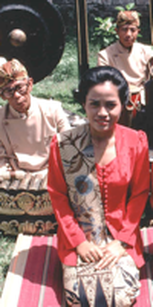
Since the war, the female solo singer, juru kawih (juru sekar or pasinden, has become increasingly prominent in gamelan. Forty or fifty years ago wayang, for instance, was often performed without a singer. That would now be unthinkable. The focus of musical interest has changed as a result. The gamelan now functions much more as an accompaniment for the vocal part, and some of the more interesting instrumental techniques are rarely used, since they would distract interest away from the vocalist.
Besides the juru kawih, there is a male vocalist, juru alok. His role is to sing during the interludes between verses. The juru alok also leads the other male musicians in the senggak. These are rhythmic cries, hoots, animal noises, shouts of encouragement, heckling and so on. They can get pretty rowdy, especially in wayang.
The increased importance of the juru kawih is undoubtedly partly the result of the advent of the microphone and sound system. Amplification (and distortion) are now ubiquitous. The popularity of jaipongan has led many younger drummers to play relentlessly in red-hot jaipongan style regardless of the musical context. This is very exciting in reasonable doses, but it is frequently overdone and inappropriate, as older musicians often complain. Despite already being very loud, at live performances the kendang are also usually miked up. It is quite often difficult to hear anything other than the singer and drummer: the gamelan is relegated to a background ripple.
Besides the juru kawih, there is a male vocalist, juru alok. His role is to sing during the interludes between verses. The juru alok also leads the other male musicians in the senggak. These are rhythmic cries, hoots, animal noises, shouts of encouragement, heckling and so on. They can get pretty rowdy, especially in wayang.
The increased importance of the juru kawih is undoubtedly partly the result of the advent of the microphone and sound system. Amplification (and distortion) are now ubiquitous. The popularity of jaipongan has led many younger drummers to play relentlessly in red-hot jaipongan style regardless of the musical context. This is very exciting in reasonable doses, but it is frequently overdone and inappropriate, as older musicians often complain. Despite already being very loud, at live performances the kendang are also usually miked up. It is quite often difficult to hear anything other than the singer and drummer: the gamelan is relegated to a background ripple.
